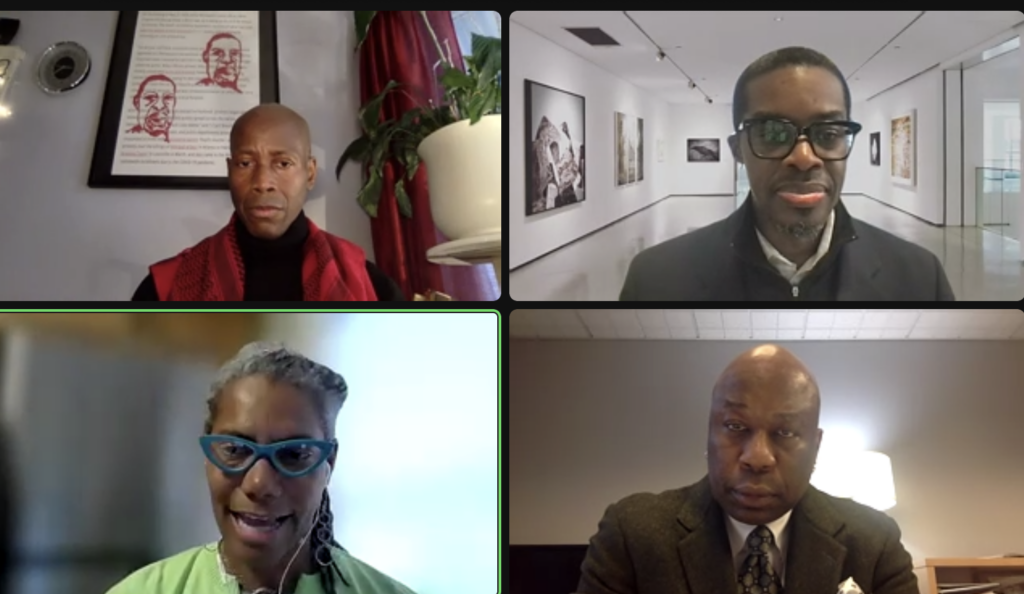Educators Discuss How to Advance Anti-Racism in the Academy

Black educators discussed how arts and communications programs can make intentional structural and pedagogical decisions to advance anti-racism in the classroom during the final session of the Teach-In on Race.
Close to 100 people attended the Zoom program moderated by Jason Mason, associate provost and dean of faculty for Massachusetts College of Art and Design (MassArt). The three panelists were Emerson’s Interim Dean of School of Communication Brent Smith, MassArt Industrial Design Department Chair Judith Anderson, and Executive Director of Berklee College of Music Ron Savage.
Savage said he feels a particular burden at Berklee due to the College’s mission statement that says the school was founded on jazz and popular music rooted in the African cultural diaspora. Savage said it comes down to two main points: values and representation

“What are our values as an institution and how do we live them out?” said Savage. “Are we teaching the people we say we’re teaching in terms of representation? Who do we invite into our community and how do we support these people?”
He quoted author James Baldwin: “I can’t believe what you say, because I see what you do.” He added that Berklee has made tremendous strides since he attended the school at the age of 16, and said the mission statement is doing its part.
Savage said Berklee started a Black scholars initiative in 2017 that includes a pre-orientation program and mentoring, and that the retention rate of Black students has tripled and the graduation rate of Black students has doubled.
“A mission statement can come to life. It’s from commitment,” said Smith. “It’s not just about diversity, equity, and inclusivity. It’s how do we bring these things to life.”
Mason asked the panelists in what ways does their background and experience inform instruction and what have they heard from their Black teaching colleagues.
Anderson said her background was working in predominantly male-orientated fields. She’s an educator, and worked in engineering and mechanical engineering in project management, and then changed to industrial design. She said a lot of her background impacts syllabi.
She spoke about a classroom assignment to design a work boot.
“Students were talking about a work boot and what does that mean?” said Anderson. “For particular students it is different than the notion of other students. For some it’s a steel-toed construction boot. For others it’s a stylish Timberland. [We need to look at] our voice and experiences in a [classroom] and we have to stop and take time to think about things like this.”
Coming from a marketing communication and business background, Smith talked about introducing students to innovators they’ve never been invited to learn about, such as Garrett Morgan, inventor of a number of devices and products, including a smoke hood and a chemical hair straightener.
“…necessity is the mother of invention…then struggle and resilience are also parents of invention,” said Smith.
Teaching the truth can create tension inside our identities, Smith said, and that tension empowers a lot of the resilience. He said people should view things as “I’m possible” instead of “impossible”.
Savage said that conflict can create resilience, and spoke about his personal expertise in teaching Black music, and specifically jazz.
“As a person who grew up in a rural town in the South, I learned music mostly through oral tradition, and then came to college and it was being taught through a Eurocentric lens,” said Savage. “I don’t believe you can authentically teach Black music or any other form separate from the culture it was born of.”
He said you can’t teach hip-hop if you don’t know about chain gang work songs, call and response, and the nature of groups singing together. He added it’s a disservice and under-prepares students to go into the world and be a practitioner of music.
Smith added that hip-hop is more diverse than a lot of people believe. He said musical groups like the Beastie Boys collaborated on and off stage with a lot of people who looked like them.
Mason asked the panelists whether anyone, regardless of their own race, can teach with an anti-racist lens.
Smith said the conversation can often be driven by a person of color, but doesn’t always have to be. He said there are a lot of educators with personal and professional experience that inform their teaching, and they can bring in colleagues when they know they can teach something to a point, but that a colleague is more suited to go further on the topic.
“I’d like students to be exposed to antiracist … education. But I don’t want the conversation to not happen if the person doesn’t look like me,” said Smith.
Categories